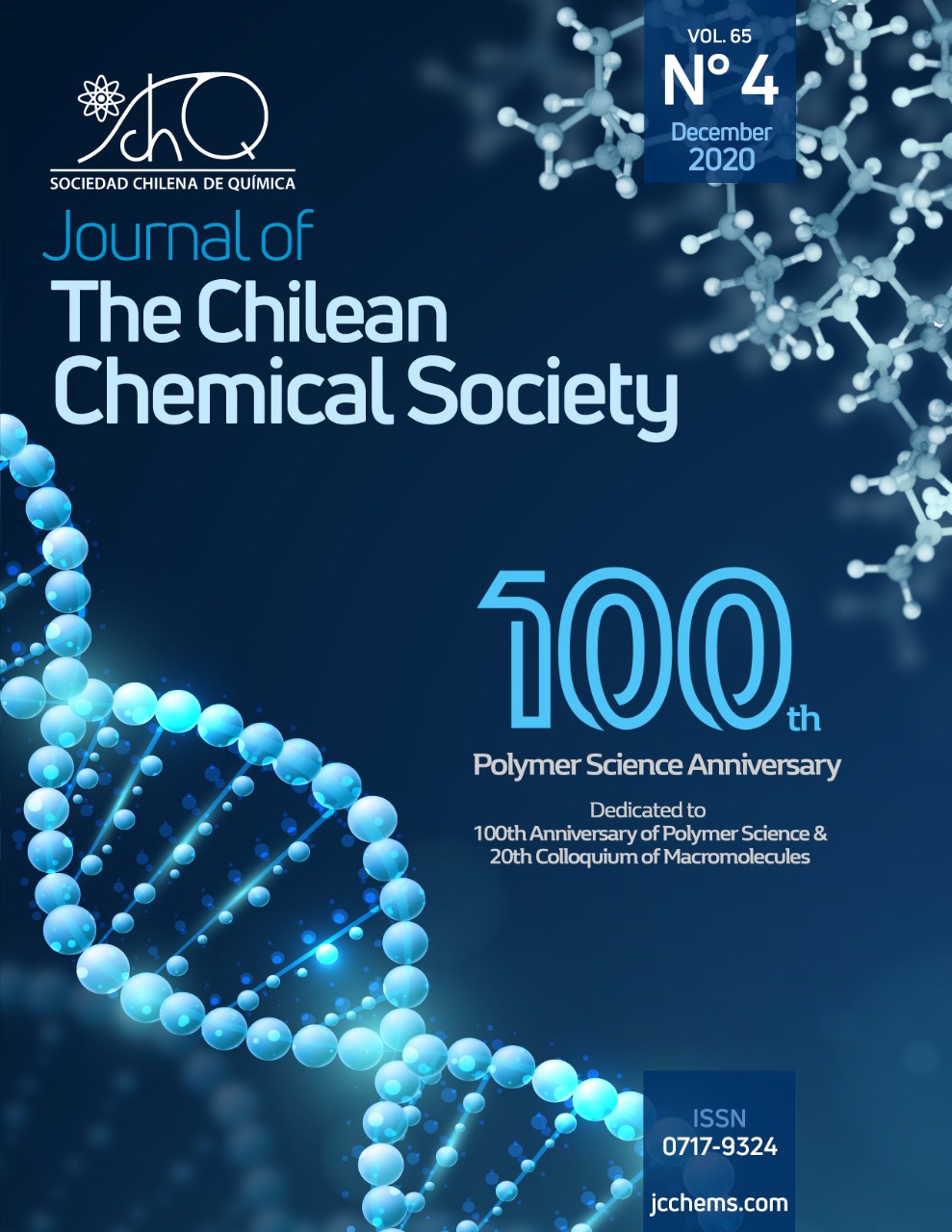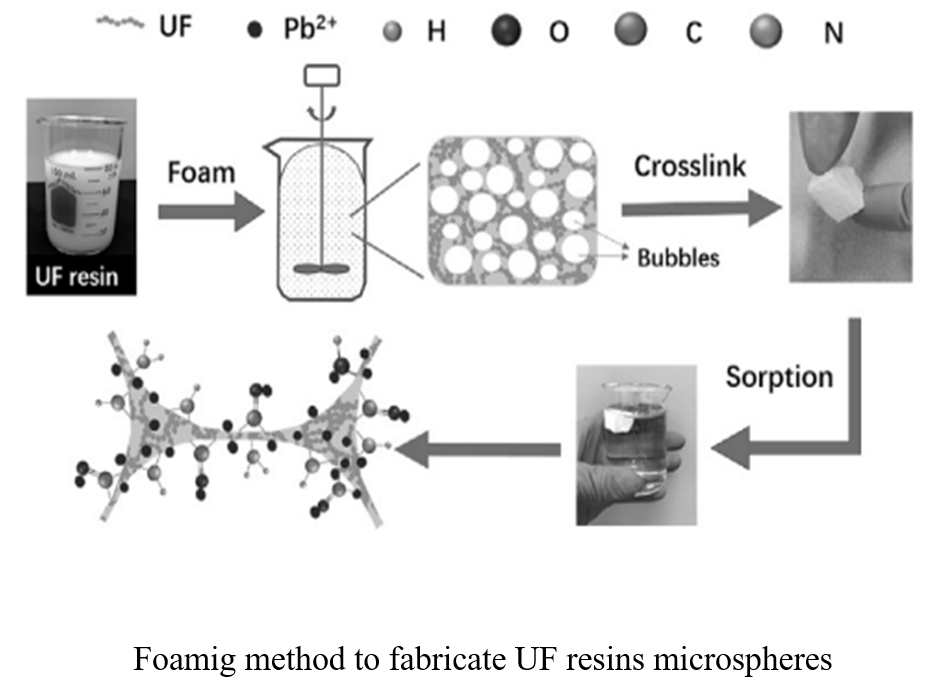AMINO-FORMALDEHYDE RESINS. PROPERTIES AND APPLICATION TO REMOVE CONTAMINANT METAL IONS. AN OVERVIEW

- Amino-formaldehyde resins, separation process, environment, metal ions, removal.
Copyright (c) 2020 SChQ

This work is licensed under a Creative Commons Attribution-NonCommercial-ShareAlike 4.0 International License.
Abstract
The global production of formaldehyde urea resins (UF) for 2019 was 6 million ton/year, being the largest use in the forestry industry in the production of MDP and MDF boards. It is in the resin industry's interest to develop other applications of these polymers.
The possible metal ion separation properties of commercial resins of the type urea-formaldehyde resins (UF), melamine-urea-formaldehyde resins (MUF), and formaldehyde melamine (MF) are achieved by modifying with functional groups.
The metal retention properties are determined by batch method in aqueous phase where the purified and sieved solid resin is put into contact with the metal ions at different pH, controlling temperature and ion force. The most studied metal ions are metal ions like Cu(II), Co(II), Cd(II), Zn(II), Cr(III), Hg(II) and Cr(VI).
The aim to contribute with this overview, is demonstrate the use of these modified resins to remove metal ions and also the potential application to use them as support to include new functional groups to increase the efficiency and affinity, Moreover, it is motivated by the production in our country of these resins and investigate possible applications in this research field.
References
- Desde el Cobre a la Innovación. Roadmap Tecnológico de la Minería 2015-2035. Fundación Chile. Santiago 2016.
- Wright J.T., White C.R , Gabrielson K., Hines J.B., Arthur L.M., Cousin M.J.,US 8,011,514 B2, sept. 6,2011.
- Wright J.T., White C.R., Gabrielson K., Hines J.B., Arthur L.M, Cousin M.,J. US 8,757,389 B2. Jun.24, 2014
- WHO, Guidelines for Drinking-Water Quality, Vol. 1, Third ed., World Health Organization, Geneva, 2004.
- Rodríguez-Cruz, L. F. Lorenzo, M. Arienzo, M. J. Sánchez-Martín, Sci.Total Env. 2007, 382, 82-92.
- F. Di Natale, A. Lancia, A. Molino, D. Musmarra, J. Haz. Mat. 2007, 145, 381-390.
- R.M. Schneider, C.F. Cavalin, M. A. S. D. Barros, C. R. G. Tavares, Chem. Eng. J. 2007, 132, 355-362.
- H. Demiral, I. Demiral, F. Tumsek, B. Karabacakoglu, Chem. Eng. J. 2008, 144, 188-196.
- P. Santander, D. Morales, B. L. Rivas, N. Kabay, I. Yilmaz, O. Kusku, Marek Bryjak Polym. Bull. 2017, 74, 2033-2044.
- M. Arany, B. Jamshidi, M. Dehvari, Pol. J. Chem. Tech. 2013, 15, 2, 40-47.
- A. Kara, E. Demirbel, Kinetic, Water Air Soil Pollut. 2012, 223, 2387-2403.
- M. Kowalczyk, Z. Hubicki, D. Kołodyńska, Chem. Eng. J. 2013, 221, 512-522.
- I. Korus, K. Loska, Desalination 2009, 247, 390–395.
- I. Ochromowicz, W. Apostoluk, Sep. Purif. Technol. 2010, 72, 112–117.
- J. Sánchez, B. L. Rivas. J. Chil. Chem. Soc. 2019, 64, 4432.
- B. Wionczyk, R. Cierpiszewski, A. Mólc, K. Prochaska, J. Hazard. Mat. 2011, 198, 257– 268.
- Rivas B.L., Moreno-Villoslada, I , J. Membr. Sci. 2000, 178, 165-170.
- Rivas B.L., Maturana H.A., Angew. Makromol. Chem., 1994, 220, 61-74.
- Rivas B.L., Pereira E.D., Moreno-Villoslada I., Progr. Polym. Sci. 2003, 28, 173-208.
- Mudzielwana, R., Gitari, M. W., Akinyemi, S. A., Msagati, T. A. M., South African J. Chem., 2018, 71(1), 15.
- Edebali, S.. J. Nanomat., Volume 2015, 2015, Article ID 697026.
- Yang, J., Yu, M., & Chen, W. J. of Ind. and Eng. Chem.. 2015, 21, 414–422
- Alhaji, N. M. I., Begum, K. M. T. M. I. Res. J. Pure Appl. Chem., 2015, 5(2), 160.
- Moussout, H., Ahlafi, H., Aazza, M., El Akili, C. J. Biol. Macromol., 2018, 108, 1063. (2018)
- Yuyang Gao, Shaoying Lui, Quinyin Wang, Gongying Wang. J. Appl. Polym. Sci., 2019, 137, 486.
- H.H. El-Nahas, S.E Abdel Aal, N.H. Thaer, Y.H.Gad, A.M. Dessouki, J. Appl. Polym. Sci.,
- , 100, 4491-4498.
- George Hovakeemian, Ma´Mun Absi-Halabi, Shawqui M. LahalLih, J. Appl. Polym. Sci.,
- , 38, 727-739.
- F. Ayca Ozdemir, Birsen Demirata, R. Apak. J. Appl. Polym. Sci., 2009, 112, 3442–3448..
- Elif Ertan, Mustafa Gülfen, J. Appl. Polym. Sci., 2009, 111, 2798-2805.
- P. Qu,Y.Li. H.Huanga, G. Wu, J.Chen, F. He, H Wang, B Gao, Chemosphere, 2020, 241, 125004.
- G. Ming, Chem. Eng. J. 2016, 15, 745-757.
- S. El-Korashy, J. Cleaner Prod. 2016, 137, 40-50.
- R. S.Azarudeen, Separation and Purification Technology. 2013, 116, 15 September, Pages 366-377.
- N. Nishat, S. Ahmad, R. T.Ahamad. J. Appl. Polym. Sci., 2006, 100, 928–936.
- B. Demirata , Mikrochim. Acta. 2001,.136,143-146.
- Methoden der Organischen Chemie (Houben‐Weyl), Band XIV/1: Makromolekulare Stoffe. Georg Thieme Verlag, Stuttgart 1962. 4. Aufl., Herausgeg. von Eugen Müller; LXIV, 1360 S., 65 Abb., 177 Tab.
- Encylopedia of Polymer Science and Technology. Wiley, New York. 1965, Vol2, p.85.
- Ahmad Baraka, P.J. Hall, M.J. Helslop. J. Haz. Mat. 2007,140, 86-94.
- V.K. Gupta, A. Rastogi, V.K. Saini, N. Jain, J. Colloid Interf. Sci. 2006, 296, 59–63.
- O. Yavuz, Y. Altunkaynak, F. Güzel, Water Res. 2003, 37, 948–952.
- S. Rengaraj, Y. Kim, C.K. Joo, J. Yi, J. Colloid Interf. Sci. 2004, 273, 14–21.
- N. Li, R. Bai, Sep. Purif. Technol. 2005, 42 237–247.
- R. Say, B. Garipcan, S. Emir, S. Patır, A. Denizli, Colloids Surf. 2002, A196, 199–207.
- P.K. Roy, A.S. Rawat, P.K. Rai, Talanta, 2003, 59,239–246.
- P.J.Hall, M.J. Heslop A. Baraka. Water Pollution VII. 2006, 95, 519.
- Ahmad Baraka, P.J. Hall, M.J. Helslop. React. Funt. Polym. 2007, 67, 585-600.
- M.A.bd El-Ghaffar, Z.H. Abdel-Wahab, K.Z. Elwakeel. Hydrometallurgy. 2009, 96, 27-34.
- Myasoedova, G.V., Antokol'skaya, I.I., Savvin, S.B., Talanta 1985, 2, 1105–1112.
- Atia, A.A., Donia, A.M., Elwakeel, K.Z., Sep. Purif. Technol. 2005, 43, 43–48.
- M Monier, Nadia H Elsayedc, DA Abdel-Latifa, Polym. Int. 2015, 64, 1465–1474.
- Qu R, Liu J, Sun C, Zhang Y, Ji C, Yin P, J. Chem. Eng. Data, 2010, 55, 4650–4659.
- Wang Z, Wu D, Wu G, Yang N, Wu A, J. Haz. Mater. 2013, 244–245, 621–627.
- Dujardin MC, Caze C., Vroman I, React. Funct. Polym. 2000, 43, 123–132.
- Wang J and Liu F, Chem. Eng. J. 2014, 242, 117–126.
- Hu X, Li Y, Wang Y, Li X, Li H, Liu X., Desalination.2010, 259, 76–83.
- Singh DK and Mishra S, Anal. Chim. Acta, 2009, 644, 42–47.
- Monier M, Int. J. Biol. Macromol. 2012, 50,773–781.


